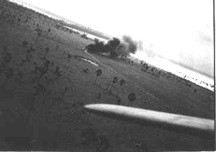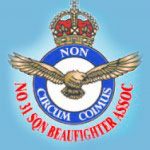War History Page 8

The sweep to the Aroe Islands on the 1st of the month was disappointing but on the last mission of the month when four crews swept the Banda Sea area the destruction of one ketch and two luggers were added to the score board. Escort was provided between the 23rd and 26th to Catalina aircraft operating on special missions to Servea and Nila Islands on four successive days. Unfortunately two aircraft were lost returning to base on the 24th – one crashing in the vicinity of Brooks Creek and the other disappearing when only 60 miles from Coomalie. The navigator of one plane was the only survivor to return to base. Four Beaufighters were based at Broome during the last half of the month to cover Catalina operations – one aircraft and crew being lost on the 18th.
The highlight of the month was the arrival of four Beaufighters and their crew of Rocket Projectile Instructors. The intensive training programme of converting squadron personnel to the use of rockets was conducted and successfully completed in ten days. In the first mission flown on the 29th, no suitable target was observed and the rockets were discharged into the sea while returning to base. During September, Squadron Leader Boyd received the immediate award of the D.F.C. for his part in the action of the 16th July, and became Commanding Officer from the 1st October 1944. On account of the projected move to Noemfoor Island, the squadron was grounded early in October to achieve full serviceability of all squadron aircraft. When the move was deferred, the squadron once more became operational, but was grounded again due to faults in the fuel line system.
In all, five sweeps and one strike were flown over Central and Eastern Timor. On one mission by two Beaufighters, captained by Flight Lieutenants Strachan and Sippe on the 13th near Lautem strip, some 200 Japanese were seen crossing a river bridge. The aircraft could not line them up because at the time they were in a tight turn, but the Japanese were observed jumping off the bridge in great confusion. Continuing on they destroyed two well-camouflaged “Dinahs” parked in disperse bays. This attack was carried out in spite of an intense barrage of ack-ack, heavy, medium and light. Another good score against the enemy was achieved on the 23rd , when six Beaufighters, led by Squadron Leader Tritton, discovered eight motor transports averaging 4-ton capacity, travelling along a road near Cape Wetoh. These were totally destroyed. On making a second run to assess the damage a ninth was seen and promptly blown apart. The balance of the trips, though not causing much damage, were of immense value to new crews, giving them their first experience of actual operations.
Early in the month some rocket projectile training was carried out. One aircraft engaged on such a flight crashed on the range, killing Pilot Officers Ingle and Way. With the move to Noemfoor being imminent, No. 31 Squadron’s operations were governed by the preparations involved. Until the 14th November the squadron was non-operational. Consequent upon orders being received for missions against targets in Timor and Tanimbar areas, flights were flown on the 15th, 16th, 18th and 21stof the month.
No. 31 Squadron was the first Royal Australian Air Force squadron to use rocket projectiles in the Pacific War Theatre.

The targets selected were Japanese occupied buildings at Natoolia (Vila Celestina da Silva) on the 16th and at Baucau (Vila Salazar) on the 21st. In the first attack forty 60-lb HE R/P badly battered and gutted the target. In the second, thirty-two 60-lb HE R/P were used. This attack on the 21st closed the squadron’s operational activity in North Western Area, and final preparations were made for the air move, which began on the 26th. Gear and personnel essential to operational requirements were moved by air transport, travelling via Merauke. The squadron’s 21 Beaufighter aircraft, loaded with extra gear and each carrying four passengers departed Coomalie on the 1stDecember, arriving at Noemfoor, where it came under the control of the First Tactical Airforce.
During its seven days stay at Noemfoor only two operations were carried out, both being escort missions to Catalinas on Air Sea Rescue work. On the 7th the squadron moved to Morotai and was based on Wama strip. It was now integrated into No. 77 Wing. The first operation from Morotai was staged on the 9th, when fourteen Beaufighters were briefed to strafe concentrations of troops and stores, and a jetty at Jolo Island, which was at extreme range. Other targets allotted throughout the month included Nanado, Goerooa, Sidato, Langgoan, Lelobata, Galela, Tansmon and numerous sweeps seeking targets of opportunity. Amongst other damage inflicted, three bridges were destroyed near Amoerang and one at Tansmon, also eight large buildings. Bombs were being used more freely in this theatre, in the use of which the pilots acquitted themselves quite -favourably. Using rockets, three ack-ack positions were knocked out, a radar station was destroyed, many buildings crippled and three jetties in both North East Celebos and Halmaheras damaged.
Strafing accounted for two coastal schooners and four barges destroyed and three barges and one small enemy aircraft probably destroyed. On the 26th December Squadron Leader J.C. Black assumed command of the squadron from Squadron Leader J. Boyd, D.F.C. and Bar. The striking power of the squadron was increased in January 1945, by the use of 100-lb napalm bombs and 325-lb depth charges. As time went on napalm bombs proved to be an excellent Beaufighter weapon. They could be dropped accurately from very low levels. Their most suitable targets were buildings and inflammable installations. Depth charges, on the other hand, needed height and frequently resulted in poor accuracy. They were unsuitable against small targets, but produced good results on lightly constructed buildings grouped together.
Over Tondano on the 2nd a Beaufighter, piloted by Pilot Officer Sounness, was hit by ack-ack in the starboard motor and ditched in the sea between the Celebes and the Halmaheras. The ditching was effected efficiently by the pilot, both crew members emerging safely. They were later rescued by a Catalina. Napalm bombs were used for the first time against the power house installations at Menando on the 5th. Twelve of the squadron’s Beaufighters attacked with six napalm bombs and ten 500-lb GP bombs and this, together with an American rocket flight, inflicted heavy damage. The following day in similar strength struck at Likoepang Village with 72 napalm bombs, finishing the attack with many strafing runs. The town was completely obliterated. On the 9th and 10th the squadron was engaged in a new role, naval spotting for the H.M.A.S. Swan, Cowra and Kapunda in a bombardment of enemy installations in the vicinity of Galela Bay. The growing tempo of the air offensive was mounting daily. Through- out January the squadron flew 254 sorties, frequently with twelve aircraft.
The Celebes was the main sphere of operations. A conservative estimate the destruction caused includes 60 buildings, three coastal schooners, a bridge, one ack-ack position and W/T installations destroyed, and many other targets damaged. Forty-nine thousand leaflets were dropped by the squadron. Activities for February were not as productive as in previous months Prime cause was a series of mishaps – some due to enemy action, some to mechanical failures and others to causes unknown. While attacking enemy emplacements at Tomolon on the 1st the enemy ack-ack claimed one Beaufighter which was seen to crash on a nearby plateau with not the remotest chance of the crew surviving. In the same action another aircraft hit over this target disappeared leaving no trace. Consequently, Flight Lieutenant Taylor, Flying Officer Packham, Warrant Officer McGuigan and Flight Sergeant Lewis were posted missing. On the 2nd an aircraft crashed on take-off, while on the 12th during gunnery and bombing practice still another crashed into the sea and Sergeant Frost was killed.
Returning from Tondano on the 14th one of the flight, damaged over the target, crashed on landing at base. During gunnery and bombing practice over the sea 20 miles from Morotai, still another Beaufighter crashed, killing Flying Officer Scarr and Pilot Officer Chester. To complete the chapter of accidents on the 18th one aircraft belly-landed on Wama strip and another lost brake pressure whilst taxying on the dispersal roadway and crashed into two Thunderbolts. Searches instituted through losses and ditchings took up valuable strike time, whilst temporary grounding of aircraft pending technical investigation further reduced operational activities. The most outstanding strike of the month, a composite one, was the attack on the 11thagainst personnel and bivouac areas and the electric generating plant at Tomolon and Tondano. The same target was bombed and strafed three days later.
On the 1st March, No. 77 Wing attacked Pagimana with 22 Beaufighters, dropping a total of fourteen 500-lb and eight 250-lb bombs. Three godowns were destroyed and two damaged and the neighbouring bridge severely damaged. Two days later the wing struck targets at Gorontalo. Two direct hits and many near misses were scored. One large barracks building was half demolished and a large double building left burning. Five strafing runs caused further damage and fires. The operational activity for the month was of a varied nature. Most noticeable was the series of armed reconnaissances, twelve in all, over Ambon, Ceram and Boeroe. Besides, sweeps were flown over the Celebes, the islands to the north, Sangihe and Taland groups and the Baggai Archi- pelago and the Soela Islands to the south. Small surface vessels and motor transports were strafed on sight. The majority of these missions faced heavy opposition from the ground defences.
In sweeps over Haroekoe, Kairatoe, Nambea and Liang from the 25th to the end of the month, strafing accounted for three enemy twin-engined aircraft destroyed, one probably destroyed and two damaged. All these aircraft were cleverly camouflaged to resemble crashed or damaged machines; therefore, great credit reflected on the crew for their perception and resultant action. Many of the squadron’s aircraft were holed by ack-ack in this series. Two Beaufighters made the return trip of 400 miles over water on one motor. On the 31st while on a sweep over Amboina Island, one aircraft was ditched in the Haroeke Straight. The crew were rescued by the superb effort on the parts of the three covering Beaufighters and the rescuing Catolina the face of intense opposition from both sides of the Strait. For this rescue two immediate D.F.C.s were awarded to squadron members, Flying Officers Sounness and Ellis, and two to members of the rescuing Catalina.
April operational activity declined due mainly to the paucity of targets within range and to factors governing the impending new sphere of operations. The principal missions were eight sweeps over Namlea, Haroekoe and Liang strips, together with armed reconnaissance of Mapanget, Sidate Langoan and Tanamon strips. A shipping search on the 4th in the vicinity of Amboina ended disastrously for the squadron. One aircraft was shot down in flames off Cape Noesanive, killing Flight Lieutenant Arbon and Pilot Officer Wood. On the 18th six Beaufighters unsuccessfully searched for an enemy gunboat in Ambon Bay. Instead, the aircraft discovered a lightly camouflaged barge which, after strafing, stopped and began smoking.
